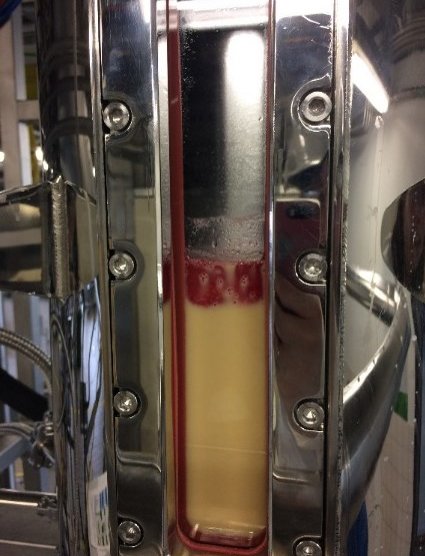Robust reactor design to simplify biomolecule production
Transitioning from fossil fuels into greener alternatives especially for sustainable aviation and long haul freight is essential to reaching global goals in reducing emissions and thereby fighting climate change. TU Delft and Delft Advanced Biorenewables (DAB) are engaged in a long term development of a low cost and robust integrated bioreactor especially for the production of biofuel precursors as well as chemical and other building blocks that have a common ‘oily’ behaviour of immiscibility with aqueous phases such a fermentation broth. Research of Rita da Costa Basto focused on the important elements of the integrated production process of hydrocarbons by the fermentative route such as coalescence and phase separation. She has defended her PhD thesis on this topic Thursday 11 January 2024 in Delft.
Mixing and separating
“Over the years, various bioreactor technologies have been developed to produce and separate biomolecules cheap and efficient”, says Rita da Costa Basto. “Many promising processes such as ours are, however, very complex and scale-up and demonstration are significant challenges for innovative technology development companies as TU Delft spin-out DAB that simply cannot afford to take large financial risks. Rita has developed, calibrated and tested a predictive model of the very heart of the bioreactor technology that allows rational design for robust and cost-effective, large industrial bioreactors on the basis of limited experimental data.”
“To produce low-cost hydrocarbons by the fermentative route, microbial cells convert sustainable feedstocks such as aqueous solutions of sugars and comparable into specific classes of biomolecules that consist mainly of hydrogen and carbon. Let’s call these specific hydrocarbon molecules ‘oil’ for the moment.” says Da Costa Basto. These specific biomolecules are used in a range of applications, including commodity products as sustainable aviation biofuels, but also for high-added value applications as cosmetics, pharmaceuticals, flavours, fragrances and much more.
During the process of fermentation, the ‘oil’ demix from the water phase with production organisms and feedstock into a separate liquid phase as small droplets, which is called an emulsion. “A well-known example of an emulsion is mayonnaise, made of egg yolk and oil. Once produced, the mayonnaise is very stable, and it becomes difficult to separate the ingredients”, Da Costa Basto adds. Similarly, it is difficult to isolate the oil, especially because microbial cells and cellular components stabilise these fine droplets and prevent them from merging into a clear biofuel or other desired product. “This is a major challenge. Ideally, we would also like to isolate the microbial cells from the mixture so that they can continuously produce more and more product.”
Imagine that you can fly without the use of fossil fuels. Wouldn’t this be world-changing?
Rita da Costa Basto, PhD candidate at the department of Biotechnology of TU Delft.
FAST integrated bioreactor
“We’re working to contribute to the proprietary FAST (Fermentation Accelerated by Separation Technology) integrated bioreactor, which is a longterm development by TU Delft and DAB for low-cost production of these bio compounds”, Da Costa Basto explains. “This intensified reactor has two compartments: a fermentation and a separation compartment. In the fermentation compartment, specific microorganisms produce the biomolecules, and an emulsion is formed. In the integrated separation compartment, the fine droplets are separated into a clear ‘oily’ stream while the water phase with microorganisms recirculates back to the fermentation compartment.”
“By developing computational models, we were able to describe, analyse and improve aspects of the reactor to optimise the process performance. Especially the multiphase fluid flow and modelling insights of my promotor prof. Rob Mudde were essential to deliver my thesis. One of the conclusions was that a design promoting larger droplet sizes leads to an improved efficiency, which we can nowadays completely quantify. Although there is still some work to do, the mathematical process model and design methodology in my thesis help promote product recovery and therefore significantly improve the production process for these ‘oily’ biomolecules”, Da Costa Basto concludes.
All in all, this research will help accelerate the energy transition.
Luuk van der Wielen, promotor from the department of Biotechnology at TU Delft.
Costs
“The FAST technology as commercialised by DAB BV could revolutionise the energy transition because it can realise significant cost reductions in the production of advanced sustainable aviation fuels and other biobased products”, says Luuk van der Wielen, promotor of Da Costa Basto. “This joint project has shown that the reactor can be developed robustly, helping technology development companies as DAB to analyse and accelerate development of these novel processes. The degree of control and robustness for any chemical process is essential for investors, especially for those seeking to minimise the risk of their investments in novel and innovative green energy and materials manufacturing.”
Collaboration with spin-out DAB
While Da Costa Basto will finalise her work with the defence planned on 11 January, the work on the reactor continues. “DAB is now scaling up the FAST integrated bioreactor, supported by our work”, Da Costa Basto elaborates.
Also Rita looks back on her collaboration with DAB happily: “We had many stimulating discussions during my fundamental research and their development of the reactor. Everyone at DAB was always helpful and made me feel to be integral part of the combined DAB-TU Delft team through the usual ups and downs of PhD research. My success is certainly significantly due to their continued support.”
Note: Since summer 2018, Dr. Maria Cuellar, Profs Sef Heijnen and Luuk van der Wielen are (indirect and minority) shareholders in DAB BV, following the TU Delft regulations for staff inventors of intellectual property.

